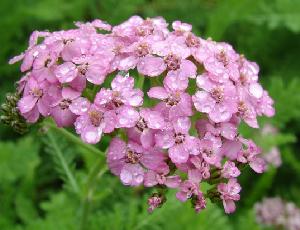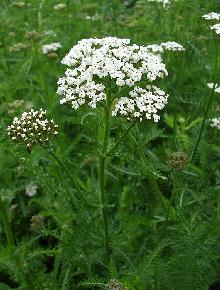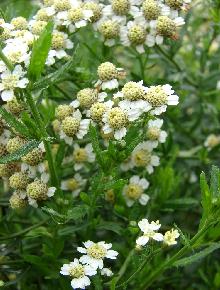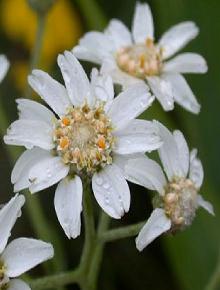Yarrow
By Debs Cook

Achillea millefolium 'Cerise Queen'
There's a nip in the air that tells me it is time to stock up on my winter cold and flu remedies. Yarrow features several of them, making it appropriate to write about Yarrow this month. This pretty and aromatic herb grows prolifically near to me providing a good supply to make tinctures, to dry ready for yarrow tea or to make a wonderful herbal inhalant, the recipe for which is given at the end of this article.
My Nanna used to warm some olive oil and add a few crushed yarrow flowers to it and leave it to 'steep' for a few minutes before popping some in my ear when I had an earache. It always helped to soothe the problem and also smelt nice.
My favorite use for Yarrow is as a tea to help cure winter colds and flu. Some claim that this tea can cure a cold within 24 hours but I wouldn't be so bold. However, I do find that it helps me to feel better. I combine equal parts of dried Yarrow, peppermint, echinacea, and elderflowers in a large container (enough for my winter supplies) and infuse 1 teaspoon of it in a cup of hot water and drink it every day to help stave off a cold. Should I be unlucky enough to catch a cold, I make up a cup of this three times a day to help ease the symptoms.
History
Yarrow is an underrated herb with many health benefits and uses. It has been used as a cold cure since before the middle ages. The Greeks used it to stop hemorrhaging and the Roman armies used it to stop the blood pouring from wounds inflicted during battle. The Druids made amulets from the Yarrow to protect the home from evil.
The English name, Yarrow, comes from the Saxon word 'Gearwe.' The Latin name, Achillea millefolium, is derived from the fact that the herb was dedicated to the God Achilles and the millefolium refers to the many fine leaflets on each yarrow leaf.
In ancient China, yarrow stalks were used for divining, although they probably used Chinese Yarrow (Achillea Asiatica). This method of divination was known as the I Ching or the Yarrow-Stalk Oracle and was done using 50 straight stalks of Yarrow. Some still use this method today although, now, the Yarrow is usually replaced by 3 coins.
In the middle ages, Yarrow was one of the ingredients in Gruit, a selection of herbs that were used to make beer, before the widespread use of hops. Other Gruit ingredients included sweet gale, mugwort, and juniper.
Folklore

Achillea millefolium
The Greeks dedicated the herb Yarrow to the God Achilles, who was said to have cured the warriors using yarrow leaves during the battle at Troy. This is probably why Yarrow is sometimes called Soldier's Woundwort. Yarrow is also known as Military Herb, Carpenters Weed, Milfoil, Old Mans Pepper, Thousand Leaf, Nosebleed, Seven Year's Love, Devil's Nettle, and Devil's Plaything amongst others names.
Folk tales tell of how Yarrow can prevent but not cure baldness. It is said to attract friends and distant relations to you and, if used in the bridal bouquet, it is believed to ensure that love will last for at least seven years. It was also believed that the Yarrow could help you find your true love, either by sleeping with the Yarrow under your pillow to bring dreams of your true love or by cutting the stems across the middle, which would reveal the initials of your future spouse. I think the weirdest suggestion I have come across is from Albertus Magnus in the15 Century who wrote in his 'Book of secrets' that if the hands are smeared with yarrow juice and then plunged into a river they will act as magnets to fish. Perhaps some anglers could try this and let me know if it works!
Description
Yarrow belongs to the Asteraceae (aster) family and there are over 100 varieties including Sneezewort (Achillea ptarmica L) and English mace (Achillea decolorans). Common Yarrow is a perennial herb that often gets listed as a weed, wildflower, or perennial garden flower dependant on which publication you are reading. It can be found in meadows, at the side of roads, in lawns and grassland, and will self-seed readily if allowed to in the garden. The clustered flat heads of creamy white flowers are 3-10 cm across and sit atop a mass of delicate fine feathery leaves.
Growing

Achillea decolorans
Yarrow grows well in most conditions. It is a prolific self-seeder, so you'll need to keep a close eye on it if you don't want it to take over your garden. It also has a creeping rootstock which helps it to spread. It is a drought-loving plant making it ideal for seaside gardens or if you have very dry soil.
To keep it happy and healthy follow these year-round guidelines: in spring, divide and replant established clumps to keep the plants fresh; in summer cut back to prevent self-seeding (unless you want it to self-seed); in autumn raise new plants from seeds or cuttings as well as divide and replant clumps.
In the garden, Yarrow is a useful plant to grow because it will help improve the health of surrounding plants due to the phosphorus, calcium, and silica the plant contains. It attracts hoverflies, ladybirds, and predatory wasps to help with aphid control. It can help to concentrate the scent and flavor of other herbs growing close by.
Yarrow isn't troubled by many pests or diseases. The only problem I've had with it occasionally is that it can suffer from mildew.
General Use
Dried yarrow flowers can be used for decoration and in potpourri mixes. You can add leaves to your compost bin to help speed up the process. An infusion of Yarrow can also be made and added to the garden to boost copper levels. Yarrow leaves have been used in snuff mixtures and a weak infusion of the flowers makes a good toner for greasy skin.
Medicinal Use

Achillea ptarmica
One of the Yarrow's folk names is Nosebleed as it was traditionally used to stop nose bleeds by putting its leaves in the nostrils. However, sneezewort can be used to start a nosebleed and was once used to relieve migraine and stuffy heads, another reason for adding it to the old snuff recipes. Yarrow can help to reduce high blood pressure, stimulate the appetite, easing stomach cramps and menstrual pain. It can be used to treat flatulence, gastritis, enteritis, gallbladder and liver problems, and internal hemorrhaging.
Yarrow contains flavonoids, alkaloids, volatile oils (one of them being camphor), phytosterols, and tannins. It also contains salicylic acid which is a component of aspirin, which may account for its use in treating fevers and reducing pain. It has also been used as a quinine substitute. Yarrow's key properties are antispasmodic, astringent, fever-reducing, mildly diuretic, and anti-inflammatory. Its ability to increase sweating is what makes this herb a favorite addition to cold cures like the one below.
Culpeper recommended a decoction of Yarrow boiled in white wine for restraining violent bleeding. For treating piles, he recommended a strong tea made from the leaves and drunk plentifully. He also recommended that equal parts of Yarrow and toadflax be made into a poultice and applied externally. Matthew Robinson, in his Family Herbal, recommended making an ointment from Yarrow which could be used to treat all 'green' wounds and other sores. He recommended chewing the leaves to ease toothache and advocated sweetening yarrow tea with honey and adding a little cayenne pepper to the tea when suffering from a cold.
WARNING - Allergic rashes and skin sensitivity to sunlight may result in prolonged use of Yarrow. Avoid large doses in pregnancy because the herb is a uterine stimulant.
Cosmetical Use
Yarrow (Achillea millefolium) extract is a perfect skin and hair care ingredient that antioxidant flavonoids, stimulating microcirculation, toning dermal vessels, and preventing hemorrhages. It balances skin oiliness, important property, especially for oily skin. Used in shampoos, Achillea millefolium extract provides incredible shine to hair.
Culinary Use
Yarrow isn't one of the first herbs that spring to mind for use in the kitchen. I occasionally add the leaves to salads and omelets; used sparingly so as not to overpower the dish. Yarrow also makes a tasty addition to chicken soups and stews. Yarrow flowers make an interesting aromatic wine which also has the benefit of being a digestive and thus an ideal aperitif. The leaves of Yarrow have been described by some as smelling like spring cabbage whereas others think it smells like sage. I find it has a fruity, grassy scent.
Recipe
Yarrow and Peppermint Inhalant

Ingredients
- 2 Teaspoons Dried Yarrow
- 1 Teaspoon Dried Peppermint
- 1 Teaspoon Dried Rosemary
- 2 Teaspoons Dried Lemon Thyme
- 2 Drops Yarrow Essential Oil
- 1 Drop Peppermint Essential Oil
- 2 Pints Boiling Water
Method
- Put the dried herbs into a large bowl big enough to hold the amount of liquid.
- Put them where you intend to use them: i.e. on a stable surface at a convenient height for you to place your head over it to inhale the vapors.
- Pour on the boiling water.
- Add the essential oil and inhale the vapors to help clear a stuffy head.
You can also put the above ingredients into a pan and simmer them on top of the cooker to let the healing vapors permeate the whole house.
